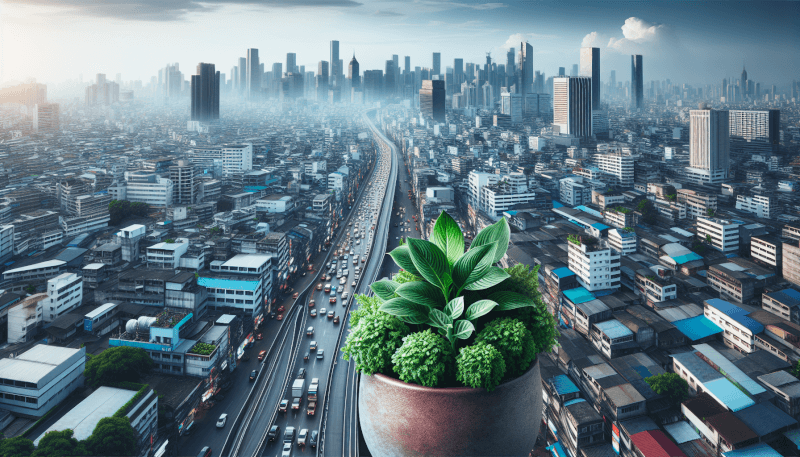Urban gardening is the art of nurturing green spaces in the midst of bustling cities, creating a harmonious blend of nature and urban living. This thriving trend offers a multitude of benefits, ranging from improved mental well-being to increased access to fresh and organic produce. In this article, you will embark on a delightful journey, uncovering the various techniques and tips to create your own urban oasis. So grab your gardening gloves, roll up your sleeves, and let’s explore the wonders of urban gardening together!

Urban Gardening
What is urban gardening?
Urban gardening refers to the practice of growing plants, vegetables, and herbs in urban areas with limited space, such as balconies, rooftops, and even indoor spaces. It is a way for city dwellers to actively engage in gardening and cultivate their own green oasis amidst the concrete jungle. Urban gardening can take various forms, including container gardening, vertical gardening, hydroponics, and green roofs and walls.
Benefits of urban gardening
Urban gardening offers a plethora of benefits, both for individuals and the surrounding community. Firstly, it allows you to reconnect with nature and experience the joy of growing your own food. Not only does this reduce your reliance on store-bought produce, but it also promotes a healthier and more sustainable lifestyle. Additionally, urban gardening beautifies urban spaces, creating a greener and more inviting environment for all. Furthermore, it contributes to improving air quality by absorbing carbon dioxide and releasing oxygen. Lastly, urban gardening fosters a sense of community and can be a great opportunity for social interaction and collaboration.
Challenges of urban gardening
While urban gardening brings numerous advantages, it also comes with its fair share of challenges. One of the main hurdles is the limited space available in urban areas, making it crucial to employ creative techniques to maximize plant growth. Another challenge lies in the socioeconomic aspects, as not everyone may have the necessary resources or access to green spaces. Furthermore, urban gardens may face issues such as limited sunlight, pollution, noise, and water supply constraints. However, with proper planning and the right knowledge, these obstacles can be overcome, leading to a thriving urban garden.
Choosing the Right Techniques
Container gardening
Container gardening is a popular technique for urban gardening, allowing you to grow plants in pots, buckets, and other containers. This method is versatile and adaptable to any space. You can choose containers of various sizes and materials, such as clay pots, plastic containers, or even recycled objects. Container gardening is especially suitable for balconies and patios, and it offers the advantage of easy mobility, allowing you to rearrange your plants as needed.
Vertical gardening
Vertical gardening is a fantastic technique for maximizing limited space in urban areas. With this method, plants are grown vertically, using walls, trellises, or specialized structures. This allows you to grow a wide variety of plants, including climbing vegetables, herbs, and flowers in a vertical arrangement. Vertical gardens not only save horizontal space but also create visually stunning green walls. They can be installed indoors, on balconies, or even on the sides of buildings, bringing life and beauty to otherwise unused surfaces.
Hydroponics
Hydroponics is a soilless gardening technique that involves growing plants in nutrient-rich water solutions. This method is highly efficient, as it requires less water and space compared to traditional soil-based gardening. In hydroponics, plants are placed in containers or trays, through which the nutrient solution flows continuously, providing the necessary nutrients directly to the roots. This technique is ideal for urban gardeners who may have limited access to suitable soil and can be implemented indoors or in small outdoor spaces.
Green roofs and walls
Green roofs and walls, also known as living roofs or vertical gardens, are innovative techniques that enable urban gardeners to transform rooftops and wall surfaces into thriving green spaces. Green roofs involve planting vegetation directly on rooftops, using special waterproofing materials and drainage systems. Similarly, green walls utilize vertical structures to support plant growth, creating a lush vertical garden landscape. These techniques provide a range of benefits, such as thermal insulation, soundproofing, and enhanced stormwater management.

Selecting the Right Plants
Choosing plants suitable for small spaces
When it comes to urban gardening, selecting plants that are suitable for small spaces is of utmost importance. Compact plants with a bushy, dwarf, or trailing growth habit are ideal choices. Herbs like basil, mint, and thyme, as well as vegetables like cherry tomatoes, lettuce, and radishes, are excellent options for urban gardens. Additionally, ornamental plants such as marigolds, petunias, and pansies can bring color and beauty to your urban oasis. When choosing plants, consider their space requirements, light preferences, and the climate of your area to ensure successful growth.
Edible plants for urban gardening
One of the most exciting aspects of urban gardening is the ability to grow your own food. Edible plants are an excellent choice, as they not only provide you with fresh and organic produce but also save you money in the long run. Leafy greens like spinach and kale, compact vegetables such as peppers and beans, and culinary herbs like rosemary and chives are fantastic options for urban gardens. Additionally, fruit-bearing plants like strawberries, blueberries, and dwarf citrus trees can add a delightful touch to your urban garden while providing tasty harvests.
Low-maintenance plants for urban gardening
For urban gardeners with busy schedules or limited gardening experience, opting for low-maintenance plants is a wise decision. These plants require minimal care and attention, ensuring that you can enjoy the benefits of gardening without feeling overwhelmed. Some low-maintenance plants suitable for urban gardens include succulents, which are drought-tolerant and come in a wide range of stunning varieties. Additionally, snake plants, pothos, and ZZ plants are known for their resilience and ability to thrive in indoor environments with minimal sunlight.
Preparing the Urban Garden
Assessing the space available
Before embarking on your urban gardening journey, it is essential to assess the available space carefully. Take note of the dimensions, lighting conditions, and any potential obstacles such as nearby buildings or trees that may cast shade. Consider the amount of space you have and plan accordingly, choosing techniques and plant varieties that will thrive in the given conditions. This assessment will help you determine the optimal layout for your urban garden and ensure that you make the most of the available space.
Soil preparation and composting
Proper soil preparation is fundamental for the success of your urban garden. If you are utilizing container gardening or green roofs, it is advisable to use a high-quality potting mix or a specially formulated lightweight soil. This type of soil is well-draining and provides adequate nutrients to support plant growth. In cases where you have access to natural soil, perform a soil test to determine its composition and pH level. Amending the soil with compost or other organic matter can improve its fertility and structure, enhancing the overall health of your plants.
Installing irrigation systems
Providing adequate water to your urban garden is essential for plant health and productivity. Depending on the size and complexity of your garden, several irrigation systems can be utilized. Drip irrigation is a popular choice, as it delivers water directly to the plant roots, minimizing water loss due to evaporation. This system can be set on a timer, ensuring consistent watering even in your absence. Self-watering containers or wicking beds are other efficient options, as they provide a reservoir of water that is gradually absorbed by the plant roots. Proper irrigation not only saves water but also promotes healthy plant development.

Maintaining the Urban Garden
Watering and fertilizing
Watering your urban garden correctly is vital to ensure the healthy growth of your plants. As urban gardens are often exposed to warmer conditions and may have limited water sources, it is crucial to water regularly and deeply. Check the moisture level of the soil to determine when it is time to water, ensuring that it is neither too dry nor excessively saturated. Fertilizing is also essential, as urban gardens may have nutrient-depleted soils. Choose organic fertilizers specifically formulated for container gardens or hydroponic systems and follow the recommended application rates to provide your plants with the necessary nutrients.
Managing pests and diseases
Pests and diseases can pose a significant threat to urban gardens, but with proactive management, you can keep them at bay. Regularly inspect your plants for signs of pest infestations, such as chewed leaves, holes, or discoloration. Use organic pest control methods, such as insecticidal soaps or neem oil, to combat common pests like aphids, spider mites, or snails. Implementing proper sanitation practices, such as removing dead leaves or plant debris, can also help prevent the spread of diseases. Finally, practice crop rotation to minimize the risk of recurring pests and diseases.
Pruning and trimming
Pruning and trimming are essential maintenance practices that promote healthy growth and shape your urban garden. Regularly trim back any dead or damaged foliage to maintain the overall health of your plants. Pruning can also help control the size and shape of your plants, preventing overcrowding and ensuring proper air circulation. Additionally, pinching off spent flowers can encourage new blooms and prolong the flowering period. Ensure that you use clean, sharp tools when pruning to minimize the risk of disease transmission and make precise cuts.
Harvesting and Enjoying the Fruits
Fruit and vegetable harvest
One of the most rewarding aspects of urban gardening is the ability to harvest fresh, homegrown fruits and vegetables. Harvesting times vary depending on the type of plant, so it is important to familiarize yourself with the specific requirements of the plants in your urban garden. For vegetables, harvest when they reach the appropriate size and ripeness. Leafy greens can be harvested by picking individual leaves or cutting the entire plant near the base. Fruits like strawberries or tomatoes can be plucked when fully ripe, while root vegetables such as carrots or radishes can be gently pulled from the soil.
Tips for using harvested produce
Once you have harvested your homegrown produce, make the most out of it with some handy tips. Firstly, wash your fruits and vegetables thoroughly to remove any dirt or debris. Consider preserving your harvest by canning, freezing, or pickling to enjoy its freshness throughout the year. Use your homegrown herbs to add flavor to your meals or create homemade herbal teas. Involve your creativity in the kitchen and experiment with different recipes to fully savor the flavors of your urban garden.
Community sharing and food security
Urban gardening can play a crucial role in fostering community connections and enhancing food security. Consider sharing your surplus produce with friends, neighbors, or local organizations. Set up a small community sharing system where people can exchange different types of produce or even gardening tips. Community gardens, where people collectively cultivate and share the harvest, are another fantastic way to build strong bonds and contribute to the overall food security of your community. By sharing and collaborating, urban gardeners can have a more significant impact on their local ecosystem.

Maximizing Limited Space
Utilizing vertical space
When space is limited, utilizing vertical space is a game-changer. Install trellises, wall-mounted planters, or hanging baskets to make the most of your vertical surfaces. This allows you to grow climbing plants or trailing vines, creating a stunning and productive garden. Additionally, consider using tiered shelving or vertical gardening systems that maximize space while providing ample growing areas for your plants. By utilizing every available inch of space, you can transform your urban garden into a vibrant vertical oasis.
Creative container ideas
Container gardening offers endless possibilities for creativity and personalization. Instead of the traditional clay or plastic pots, explore alternative container options to add a unique touch to your urban garden. Upcycle old tires, buckets, or wooden crates into planters, infusing a rustic charm into your space. Repurpose mason jars or wine bottles as mini herb gardens or terrariums. Additionally, consider using hanging shoe organizers, gutters, or even old gardening boots as unconventional yet innovative containers. Let your imagination run wild and transform everyday objects into extraordinary homes for your plants.
Companion planting and intercropping
Companion planting and intercropping are clever techniques that generate multiple benefits in limited space. By growing compatible plants together, you can maximize resources and enhance plant growth. For example, pairing taller plants with shade-tolerant or quick-growing varieties allows you to optimize sunlight exposure and utilize vertical space effectively. Intercropping, on the other hand, involves planting different crops together in a single area. This technique helps deter pests, improve soil fertility, and increase overall productivity. By employing these symbiotic planting strategies, you can create a diverse and harmonious urban garden.
Connecting with the Community
Joining community gardens
Community gardens are a fantastic way to meet like-minded individuals, learn from experienced gardeners, and foster a sense of belonging. These shared spaces offer opportunities to collaborate, share resources, and exchange knowledge. Consider joining an existing community garden or become involved in the establishment of a new one. By contributing your time and skills, you not only enrich your own gardening experience but also strengthen the bonds within your community and create a greener and more resilient neighborhood.
Sharing and exchanging plants and seeds
Sharing and exchanging plants and seeds is another wonderful way to connect with the gardening community. Participate in seed swaps or plant exchanges to diversify your urban garden and discover new varieties. By sharing your own plants and seeds, you contribute to the collective growth and success of other urban gardeners. This practice not only increases the variety of plants in your space but also fosters a lively and supportive ecosystem of plant enthusiasts.
Collaborating with local organizations
Collaborating with local organizations can help amplify the impact of your urban garden. Reach out to community centers, schools, or nonprofits to discuss potential collaborations. For instance, you can offer workshops or demonstrations on urban gardening for interested individuals or participate in outreach programs that promote sustainable living. By working together, you can create educational opportunities, advocate for green spaces, and inspire others to embrace the beauty and benefits of urban gardening.

Overcoming Common Challenges
Limited sunlight and shade management
Limited sunlight can be a challenge in urban gardening, especially when surrounded by tall buildings or dense tree canopies. However, with some creative solutions, you can overcome this obstacle. Opt for plants that thrive in shade or consider creating shade structures using umbrellas or shade cloths to protect delicate plants from harsh sun exposure. Position your planters strategically, taking advantage of the available sunlight. Furthermore, choose reflective or light-colored containers that can bounce light onto your plants, making the most of the limited sunlight in your urban space.
Dealing with limited water supply
Water scarcity is a common issue in urban environments, and it poses a challenge for urban gardeners. Implement water-wise practices to optimize your water usage. Collect rainwater in barrels to use for watering your plants. Consider installing a drip irrigation system or self-watering containers that minimize water loss. Additionally, choose drought-tolerant plants that require less water and practice mulching to retain moisture in the soil. By understanding your water needs and utilizing efficient water management techniques, you can maintain a thriving urban garden while conserving water resources.
Noise and pollution considerations
Urban areas are often characterized by noise and pollution, which can impact the health of your plants. Dust and pollutants in the air can settle on leaves and hinder photosynthesis, leading to stunted growth or discoloration. Additionally, excessive noise can stress plants and disrupt their natural growth patterns. To mitigate these issues, regularly wipe down your plants’ leaves to remove dust and pollutants. Consider using air-purifying plants, such as spider plants or peace lilies, to combat indoor pollution. Provide a quiet and peaceful environment for your plants, minimizing noise disturbances whenever possible.
Conclusion
Urban gardening offers a world of possibilities and benefits, allowing you to cultivate your own green haven in the midst of the city. By choosing the right techniques, selecting suitable plants, and overcoming challenges, you can create a thriving urban garden. From container gardening to vertical gardening, and from edible plants to low-maintenance varieties, there is a gardening style and plant selection for everyone. Utilize your limited space creatively, connect with the community, and maximize the rewards of your urban garden. Through urban gardening, you can not only enjoy a bountiful harvest but also contribute to the beauty, sustainability, and well-being of your urban environment. So grab a watering can and get ready to embark on your urban gardening journey – your green oasis awaits!


